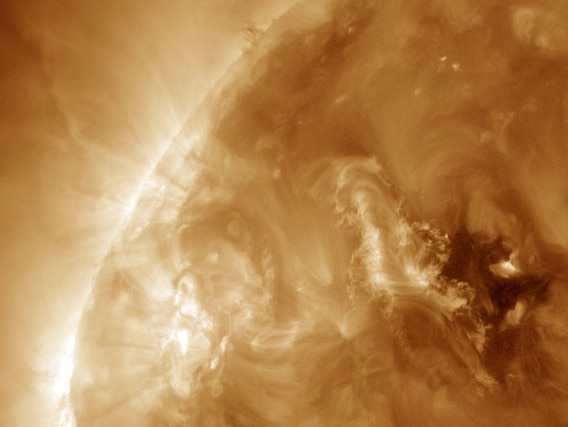Create a free profile to get unlimited access to exclusive videos, sweepstakes, and more!
The Roiling, Twisted Wreckage of a Solar Eruption

On Jan. 23, 2013, the Sun decided to lose a little weight. Not much, you understand, just a few pounds here and there. Well, actually, not just a few pounds. More like a few hundred million.
On that date, and taking about seven hours to complete, a towering arch of solar material blasted off into space. Thatâs cool enough, but the wreckage it left behind on the Sun is nothing short of awe-inspiring:
The footage you just saw was from NASAâs Solar Dynamics Observatory, which stares at the Sun 24 hours a day. It has cameras that can see in the far-ultraviolet, where the Sunâs bizarre and complex magnetic fields become apparent. Magnetism rules the surface activity, from sunspots to vast explosions of energy, so these UV observations are critical to understanding the processes.
In a nutshell, one of the most basic laws of physics is that a moving electric charge generates a magnetic field. The Sun is made of mostly hydrogen and helium, with a few other elements sprinkled in, and deep inside the Sun itâs hot enough to strip the electrons from their parent atoms, creating charged particles (called ions; the ionized gas is called a plasma). Not only that, but the hotter stuff from deeper inside the Sun rises to the surface and cooler material sinksâthis is called convection, and itâs the same reason hot air balloons float and a boiling pot of water roils. Because the charged particles are moving, they make magnetic fields.
The convecting material rises in a huge column a thousand kilometers across (roughly as big as Texas), and carries with it that complex magnetic field. These connect up with the magnetic fields of other cells, creating magnetic chaos. Once they pierce the surface, the magnetic field lines can actually prevent the cooling gas from sinking; it stays near the top, cools, and grows darker than the stuff around it: behold, a sunspot!
The plasma flows along these magnetic field lines, sometimes arcing up in loops going from sunspot to sunspot, reaching heights of tens of thousands of kilometers. The plasma can also be stretched out into a shallower arch called a prominence, which can be a hundred thousand kilometers long. If the magnetic field lines controlling the prominence get tangled up they can short out, and the material can either fall back to the surface of the Sun, or be launched into space. In the case of the prominence on Jan. 23, the material erupted away when the magnetic field lines snapped, and all those disjointed magnetic field lines reconnected with each other after the explosion, causing that amazing roiling of bright solar material in the aftermath. It looks like a horizontal tornado.
Incredibly, very little of this could be seen in visible light, the kind our eyes see. But in the ultraviolet, it was all laid out for SDO to capture.
In fact, the Sun erupted twice that day, both times ejecting huge quantities of plasma into space. These coronal mass ejections, as theyâre called, blast billions of tons of subatomic particles away from the Sun, each wave carrying its own magnetic field. If they hit the Earth, they interact with our own magnetic field, producing aurorae. One of the CMEs from Jan. 23 did in fact hit us, and created a mild effect. Sometimes, though, the interaction is huge, and can make the Earthâs magnetic field ring like a bell. This can generate big current of electricity under the Earthâs surface (called geomagnetically induced currents) that can cause power outages. They can also affect satellites, messing up GPS and communications.
For this reason Iâm very glad we have satellites like SDO. The Sun is a star, capable of vast episodes of violent activity that affect us on Earth. Itâs a very good thing weâre trying to understand it better.


























